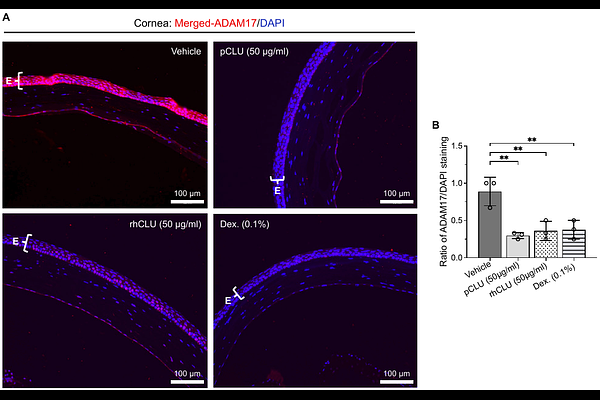Clusterin reverses epitheliopathy, reduces inflammation, and restores goblet cells and corneal nerves in a mouse model of autoimmune dry eye

Clusterin reverses epitheliopathy, reduces inflammation, and restores goblet cells and corneal nerves in a mouse model of autoimmune dry eye
Franz, J.; Ng, T. F.; Gupta, S.; Wilson, M. R.; Fini, M. E.; Masli, S.
AbstractChronic ocular surface disease (OSD) is characterized by corneal epitheliopathy, reduced barrier function and loss of nerves, accompanied by persistent inflammation. Current treatments offer limited relief and there is no approved therapy that promotes neurosensory regeneration in OSD. Here, we tested the therapeutic efficacy of clusterin (CLU), a molecular chaperone and MMP9 inhibitor found in tears, in Thbs1-deficient mice, a preclinical model of autoimmune dry eye associated with Sjogren`s disease (SjD). These mice were treated topically at the ocular surface, bilaterally, for 3 weeks with recombinant human CLU (rhCLU) or human plasma- derived CLU (pCLU) eyedrops and compared to standard-of-care 0.1% dexamethasone eyedrops. Treatment with CLU significantly improved corneal barrier integrity, increased corneal nerve density, enhanced the proportion of corneal nerves with immunoreactivity for CGRP and promoted conjunctival goblet cell regeneration. Furthermore, CLU reduced immunoreactivity for ADAM17 in the corneal epithelium and reduced Tnfa expression in the conjunctiva, supporting its anti-inflammatory effect. Notably, all these effects were comparable to, or even exceeded, those resulting from treatment with dexamethasone. Based on its efficacy, we introduce CLU as a multifunctional and promising biotherapeutic for a widespread range of ocular inflammatory conditions involving corneal epitheliopathy and nerve loss, including dry eye associated with SjD.